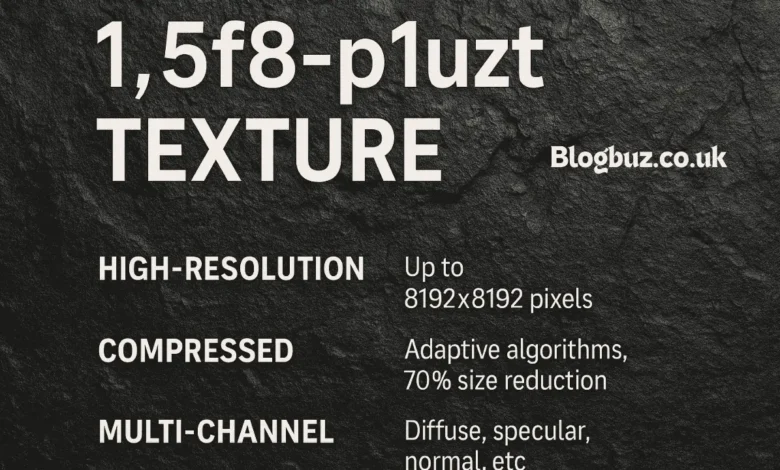Exploring the 1.5f8-p1uzt Texture: The Future of High-Performance Digital Textures

In the ever-evolving world of digital design, gaming, and visual effects, the demand for high-resolution, realistic textures has never been greater. One term that has been making waves across design forums and development teams is the 1.5f8-p1uzt texture. But what exactly is it, and why is it gaining so much attention? This comprehensive article explores the features, benefits, technical aspects, and future potential of the 1.5f8-p1uzt texture format. Whether you’re a game developer, a 3D artist, or a tech enthusiast, understanding this innovative texture format could give you a crucial edge in your creative projects.
What is the 1.5f8-p1uzt Texture?
The 1.5f8-p1uzt texture is a high-resolution digital texture format known for its advanced surface realism, exceptional compression efficiency, and wide-ranging compatibility. Developed to meet the modern needs of digital design professionals, it delivers detailed surface representations while keeping performance in mind. The texture is widely used in industries such as video game development, virtual reality (VR), architectural visualization, and even digital product prototyping.
Key Features of the 1.5f8-p1uzt Texture
- High-Resolution Fidelity: The 1.5f8-p1uzt texture can render textures in resolutions up to 8192×8192 pixels, providing incredibly detailed surface features. This makes it ideal for environments where visual immersion is critical.
- Advanced Compression Algorithms: Unlike traditional formats, this texture type uses adaptive compression that reduces file sizes by up to 70% without sacrificing visual quality. This saves storage space and improves load times in real-time applications.
- Multi-Channel Support: The format supports various texture maps, including diffuse, specular, normal, ambient occlusion, and displacement. This makes it versatile for a range of use cases.
- Cross-Platform Integration: Whether working in Unity, Unreal Engine, Blender, or Autodesk Maya, the 1.5f8-p1uzt texture format integrates seamlessly with minimal setup.
- Low Memory Footprint: This format is suitable for both high-end and mobile platforms thanks to its optimized buffer sizes (ranging from 128KB to 2MB).
Technical Specifications
- File Extension: .1f8p
- Color Depth: 16-bit per channel
- Compression Ratio: Up to 70% reduction from raw formats
- Compatibility: Unity, Unreal Engine, Blender, Maya, 3ds Max
- Buffer Sizes: 128KB to 2MB, depending on texture resolution and content
Applications of the 1.5f8-p1uzt Texture
The versatility of this texture format makes it an asset in a broad spectrum of industries:
- Gaming and VR: Enhance the realism of virtual environments and characters, contributing to immersive player experiences.
- Architectural Visualization: Produce photorealistic renders of building materials and environments for presentations and design approvals.
- Product Design and Prototyping: Before physical manufacturing, simulate real-world materials like metal, fabric, or plastic in digital prototypes.
- Film and Animation: High-resolution textures are vital in achieving the visual fidelity required in modern cinematic productions.
Benefits of Using the 1.5f8-p1uzt Texture
- Performance Optimization: Reduced file sizes and optimized memory usage result in faster render times and better performance in real-time applications.
- Visual Realism: Enhanced detail and depth contribute to the overall quality of the ultimate output, whether in games, movies, or product simulations.
- Workflow Efficiency: The format’s compatibility with popular design software ensures a smooth workflow from design to implementation.
- Scalability: Whether you’re working on a mobile app or a AAA game, this texture format scales effortlessly to meet your needs.
Creating and Customizing 1.5f8-p1uzt Textures
- Blender: Use nodes and shader editor to create detailed procedural textures.
- Substance Painter: Ideal for painting textures directly onto 3D models with high levels of realism.
- Autodesk Maya: Offers comprehensive tools for texturing in complex animations and VFX pipelines.
Best Practices for Optimization
- Use Mipmaps: Generate multiple texture detail levels to improve performance based on camera distance.
- Implement LOD (Level of Detail): Dynamically adjust texture resolution to optimize rendering.
- Choose the Right Compression Format: Options like BC7 and KTX can help maintain quality while reducing size.
- Test Across Devices: Ensure your textures render well across different hardware configurations.
Future of 1.5f8-p1uzt Texture Technology
The future looks bright for this texture format, particularly with advancements in AI and procedural texturing. Developers are beginning to leverage AI to dynamically generate textures based on scene context, while procedural generation allows for endless variations with minimal manual input.
We may also see tighter integration with emerging platforms like AR glasses and holographic displays, where efficient and realistic textures will be critical.
Conclusion
The 1.5f8-p1uzt texture represents a significant leap forward in digital design. Its high resolution, efficient compression, and broad compatibility make it a powerful tool for creators across various industries. As technology continues to evolve, the function of sophisticated texture formats like 1.5f8-p1uzt will only become more pivotal in pushing the boundaries of what’s possible in digital visualization.
FAQS
What makes the 1.5f8-p1uzt texture format different from traditional formats like PNG or JPEG?
The 1.5f8-p1uzt format offers significantly better compression efficiency and higher fidelity. It supports multi-channel maps like usual, displacement, and ambient occlusion. Unlike traditional formats for static images, it’s also optimized for real-time rendering.
Can the 1.5f8-p1uzt texture be used in mobile game development?
Thanks to its low memory footprint and adaptive compression, the format is well-suited for mobile platforms without sacrificing texture quality or performance.
Which software supports editing or rendering with 1.5f8-p1uzt textures?
Major platforms like Unity, Unreal Engine, Blender, Autodesk Maya, and 3ds Max support the 1.5f8-p1uzt texture format with seamless integration and minimal setup.
How does the 1.5f8-p1uzt texture contribute to performance optimization in 3D applications?
With its reduced file sizes (up to 70% smaller than raw formats) and optimized buffer sizes, this format helps speed up load times, decrease memory usage, and improve overall rendering performance.
Is the 1.5f8-p1uzt texture format suitable for procedural or AI-generated textures?
Yes, the format is highly compatible with procedural generation workflows and AI-enhanced texturing, making it ideal for scalable, dynamic content creation in next-gen projects.
You May Also Read: TGD170.FDM.97 New Release: A Revolutionary Leap in Data Management and Digital Security




